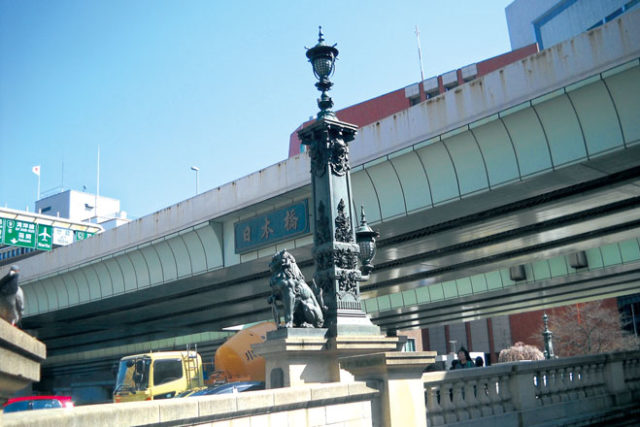By Yukiko Tanaka
For The North American Post
When you get to the end of Amazake-yokocho (about 20 minutes on foot) you see a narrow greenbelt and a park, then, on your right, a shrine of Suitengu (in its temporary location while the original nearby is undergoing major repair).
Ningyocho as a whole had flourished in the old days because of this shrine. The shrine, always busy with young women (or couples) and pregnant women with their mothers, is for those who wish for an uneventful delivery of a baby or, for that matter, conceiving one.
I find this strange because the shrine is supposed to honor the tragic mother who had lost her only child at sea as told in the medieval story of the “Tale of Heike.” In any event, the shrine compound is particularly crowded on the day of its fair–the fifth of each month–when the street is full of stalls. If you come this far you should be able to see Sumida River beyond its concrete embankment.
If you walk on the broad street of Kiyosumi from Hamacho Subway Station, heading further northwest of Suitengu, and cross over Edo-dori you will find yourself in Bakuro-cho neighborhood.
Bakuro were the men who dealt with horses for transportation needs; they lived or hung out in this neighborhood, thus the name. Today, this area, called Bakuro-Yokoyama, is a concentration of wholesale businesses for fabrics and clothing.
In nearby Kodenma-cho and to the west was the famous Edo prison; it was here that a hundred or so criminals, both common and political, were placed all year round. Among those who spent their last days in this prison was Yoshida Shoin, philosopher and educator of Choshu Domain, Shoin’s crime was his failed attempt to meet with American Commodore Mathew Perry (who had come not far from the Edo Castle with a fleet of battle ships). Earlier, Takano Chomei, a Dutch scholar, was put in there for having translated an anatomy book from Dutch to Japanese. Where this famous prison was once located is now a quiet residential area with an adjacent park (Jushi Park), school and temple.
Having explored Ningyocho and its northern area, you will head south towards the heart of Nihonbashi neighborhood. The name, meaning “bridge of Japan,” comes from an actual bridge, which is on the Nihonbashi River, which runs into the Kanda River to the south, then to the Sumida River. The original bridge–in wood and arched, of course–can be seen in Ukiyoe woodcut prints by Ando Hiroshige and others. To the east, toward the Edo Castle (now Imperial Palace compound) and immediately outside of its outer-moat ,is the reclaimed land of Tokyo Bay’s marshes.
The Nihonbashi area was once in marshes, uninhabited until a war lord named Ota Dokan was built a fort-like structure, in the 15th century; later, another war lord.
Tokugawa Ieyasu decided to build a large castle there when he was successful in unifying Japan, the beginning of the Tokugawa (or Edo) period that would last for two-hundred fifty years. There were streams going through this land and Ieyasu had canals dug mainly for transport. Then, Nihonbashi Bridge went up in 1603 and remains in the same spot today, although what we see now is in stone and was built in 1911.
Once, distances on major highways that stretched out of Edo were measured with Nihonbashi Bridge as the starting point (you can find the mark telling to that effect on the ground by the bridge). Streets by and around it were naturally very busy; there were fish markets along the Nihonbashi River until they were relocated after the Great Kanto Earthquake of 1911 to Tsukiji (and, in 2016, it will move again to Toyosu, a newer reclaimed land further southeast).
As many other types of merchants set up their businesses near the bridge as well, the area, named the “kitchen of Edo,” was very busy indeed. Here, by the market, was a spot where the heads of hanged criminals were displayed, presumably to teach a lesson to the passers-by.
[Editor’s Note]
This series will be published every week. The writer can be reached atytanaka03@gmail.com.






